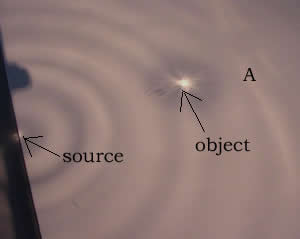Small vs long
wavelength.
Many of us are aware of the magnetron's ability to produce high energy microwaves. It is the source of energy in our microwave ovens at home. In February of 1940, the first working magnetron was tested by an English research team under the direction of an Australian physicist Mark Oliphant. Researchers were amazed to find that it produced over 400 watts of power, 100 times more than any other device known at the time, at the extremely short wavelength of 9.8 cm. The magnetron was then mass produced in the U.S. and made a significant contribution to the war effort. The relatively small wavelength of microwaves meant that very small objects could be detected. A periscope on the surface of the ocean could now be detected from a distance of 10 km.
Lets see how waves with a long wavelength differ from those with a shorter wavelength.
By using a Ripple Tank we can demonstrate how waves of different wavelengths behave as they hit a distant object. The picture on the right shows waves, of relatively long wavelength, striking a distant object. Notice how the waves reflected back to the source are weak or non-existent and the area "A" behind the object has very little shadow.
Click to see a 300 kb video

Notice the difference when waves with relatively short wavelengths are used. The reflection back to the source is stronger and there is a significant shadow at "A".
Click to see a 300 kb video
